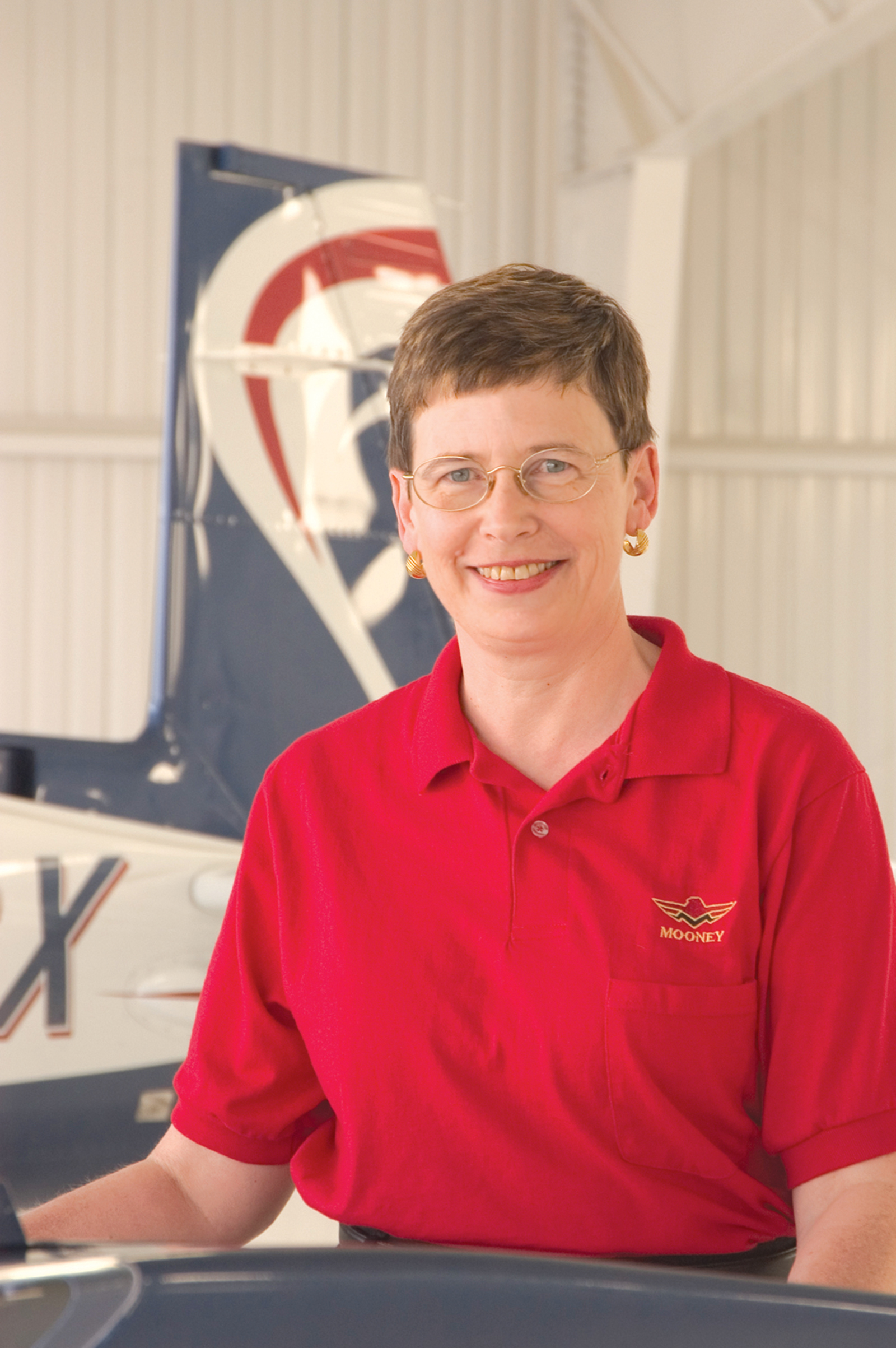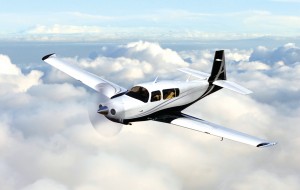By Karen Di Piazza
In April, during Sun ‘n Fun in Lakeland, Fla., Mooney Airplane Company announced a new product. That hadn’t happened in more than a decade for the 61-year-old company based in Kerrville, Texas.
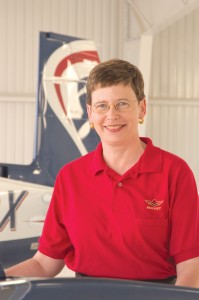
Mooney Airplane Company CEO Gretchen Jahn is the first female to be elected as a CEO of an aircraft manufacturer. She’s also the first female to do so coming from outside of the aviation industry.
When it was their turn to hold a press conference at the event, in a theatrical-like performance, Mooney staff, dressed in black, confidently pulled off a black cover to reveal the four-place, turbo, high-performance piston Acclaim. Mooney CEO Gretchen Jahn, sitting in the cockpit, smiled at the crowd.
“We kept it a big secret!” says Jahn with a laugh.
Jahn has taken the aviation industry by surprise. That’s an understatement, though, of where she’s taken Mooney. Before she arrived at Mooney in November 2004, replacing J. Nelson Happy, no one was very happy; employee count was down to 145 and aircraft deliveries for that year had sunk to 36. There was also talk of filing bankruptcy again—closing the doors for good.
Under Jahn’s leadership, aircraft deliveries in 2005 more than doubled, to 85. So, it was no surprise when Jahn also became president and CEO of Mooney’s parent company, Mooney Aerospace Group, Ltd., a publicly traded company, on July 21, 2005.
“I am sort of a novelty—both as a female CEO that is actively flying and racing planes, and as a female CEO of an aircraft original equipment manufacturer,” she said.
Jahn has been an avid pilot for more than two decades. She’s a member of the Colorado Pilots Association and The Ninety-Nines and is a board member and treasurer of Air Race Classic, Inc., in which she races annually and made its Top 10 in the 2005 international Air Race Classic.
“In terms of being a private pilot, I’ve never looked back, but I never incorporated it into my worklife until recently,” she says. “So that’s a real novelty in this industry. The only other female CEO of a manufacturer today is June Maule of Maule Air, Inc., but that’s because her husband, Belford D. Maule, died. The same thing held true for Moya Lear and Olive Ann Beech, who both took over as CEO after their husbands, respectively, Bill Lear and Walter H. Beech, died. So, I’m the only one that’s come in from the outside! And I don’t know of any other CEO that races airplanes.”
Breaking the metaphoric glass ceiling, particularly in aviation, where it has been a male-dominated run industry, is a triumph for Jahn—and for her mother, too, as her dream for Jahn was to become a “great corporate wife.” Overseeing Mooney, though, is far from her first CEO post, in which she’s turned out to be a great corporate leader.
In 1979, Jahn founded Conformation, Inc., a software consulting business. She remained the firm’s president until 1991, when she merged it with Mile-High Information Services; she served as the company’s principal and vice president until 1994, when she left to join MIS, Inc., as vice president of engineering. She later founded Aegis Analytical Corp., a quality compliance and performance management software manufacturer for the pharmaceutical and biotechnology markets, and remained president and CEO until 2002. In 2003, Jahn assumed the presidency of Knotridge Corp., a business planning and consulting firm that specializes in the evaluation and management of start-up enterprises.
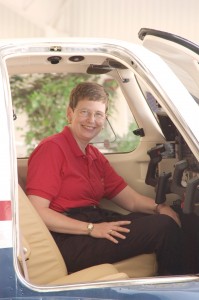
Gretchen Jahn, an avid pilot for more than 20 years, is CEO of Kerrville, Texas-based Mooney Airplane Company and president of its parent company, Mooney Aerospace Group, Ltd., a publicly traded company.
Jahn’s IT acumen explains why Mooney’s website has a fresh look and is more intuitive for users. Additionally, she’s held executive positions at MDC Holdings and HomeAmerican Mortgage. With her experience in processes and productivity, spanning from manufacturing and service firms, to metal fabrication, to meat packing to pacemakers, she’s proven she knows how to lead and get results—a missing ingredient at Mooney until Jahn’s arrival.
Jahn thought hard and long before making the decision to join Mooney, and employees are thrilled that she did. That showed when they lined up at the Kerrville plant to sign her 2005 Ovation 2 GX.
Jahn’s path in the world and at Mooney
Jahn is a people person, so she discovered the world of human behavior and psychology. She attended Lawrence University in Appleton, Wis., becoming a cum laude graduate and getting a bachelor’s degree in psychology. She later attended the University of Colorado in Boulder, Colo., and obtained her master’s in experimental psychology.
“Experimental psychology is about human memory learning and language—how people learn,” says Jahn. “Understanding how people learn has helped me in my career.”
She also obtained her certificate in integrated resource management from the American Production and Inventory Control Society.
“This has all been an interesting life journey,” she said. “In my opinion, there are two different ways to make your path in the world. There are those people who really know what it is that they want, and they spend their life pursuing that; the road may not be completely straight, but they have a clear vision who they want to be, what they want to do, where they want to go and they do what they can to get there.
“Then, there are folks like me; there isn’t an end goal that looks like that. Instead, it’s been a personal discovery of my own interests and capabilities—pursuing the interests and honing the capabilities as an offer to those around me—to friends, employers and to groups that I belong to.”
Jahn said she’s evaluated what she’s good at, and has come to a conclusion: she’s good at what she likes.
“I’ve packaged that into a particular career pursuit, which comes into play with the love of manufacturing, the love of aviation, systems, business, and people as a whole,” she says. “Being the CEO of Mooney is an opportunity to combine all those things into one place. I find these things technically challenging, yet there’s a lot of the human element to it—the people components. Getting the technical things and the people all working together toward a common goal—it’s organization and problem solving. And it’s an opportunity, when it’s all said and done, to have a tangible outcome with whatever it is that you’re making.”
Being a good “leader”
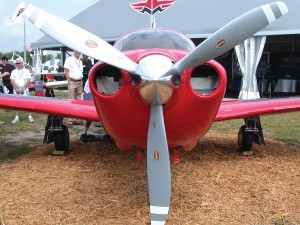
In April, during Sun ‘n Fun in Lakeland, Fla., Mooney Airplane Company revealed the Acclaim, the fastest four-place turbo ever built.
Jahn says she’s good at “organizing people, working with people and motivating people.” She believes those qualities make her a good CEO. She’s always thinking about problems and asking questions, which she explained provokes a different kind of thinking process to solve problems faster.
The corporate feel-good phrase used by a lot of human resource departments, “a good CEO guides people,” isn’t Jahn’s interpretation of what makes a good CEO.
“Guiding people is too gentle of a term; leading demands more,” she says.
She said to guide someone means that the “other person has set the direction.”
“Guiding someone is to help them achieve their direction, but as a CEO, leading is setting the direction, so, you’re working with folks to go in the direction in which you’re leading,” she explained. “To lead, you have to show the example; you have to be willing to provide energy.
“As a leader, my responsibility is to say, ‘We’re going there.’ Then you work with folks in terms of what it means to get there. But, if they say, ‘Well, you might consider not really going there, but maybe a little left or the right of there,’ it might make sense. Leading depends on the nature of the decision, and in every decision it’s always important to get buy-in from people.”
But getting people’s buy-in, says Jahn, isn’t the same as getting their consensus.
“Getting consensus is where you have everyone’s opinion, and it’s not until everyone agrees that you move in a certain direction,” she said.
Conversely, she said that getting buy-in from employees doesn’t necessarily mean those individuals were part of the decision-making process.
“But getting people’s buy-in matters because it means that their opinions have been taken into account,” she said. “They can understand that a decision that has been made is good for them as an individual, good for the company and is a good direction to go in.”
Jahn says she encourages people to come to her with questions, especially if they’re having difficulty getting results on something.
“I’m approachable as a CEO, but some CEOs aren’t, and that’s kind of scary,” she said. “People come up to me about stuff all of the time, but they know it has to be something that’s important and worthy of attention. If they haven’t already done their own homework—done the things that they have within their purview, within their power—then I’m not going to be particularly sympathetic. But if they’ve done all of the right things along the way, and they’re still not getting results, they know that I’ll listen.”
From Mooney chaos to organization and revitalization
When Jahn walked into the Kerrville plant for the first time, it was chaotic.
“There was stuff everywhere,” she said. “Nobody knew where anything was.”
From Jahn’s experience in running profitable companies, she knew Mooney couldn’t become successful unless the plant cleaned up its act, literally. She quickly implemented the “Japanese Five S’s. Translated into English these five rules don’t all start with the letter “S,” but mean: to sort, organize, clean up, have a positive state of mind, and have discipline.” It sounds so elementary, but Mooney’s male leadership before Jahn got there didn’t know how to implement a clean-up program.
“If you can find what you need right then, and put it where you can get it, with the rest being stored or thrown out, it adds more working space in the factory,” she said. “Of course, with the clutter gone, it improved efficiency on all levels.”
She applied the same clean-up principles to aircraft manufacturing. In doing so, Mooney reduced cost because it didn’t take as long to get something done, and waste overall was reduced.
“Although the company has seen tremendous growth and we’ve come a long way, we still have a ways to go,” she noted. “This year, we’re looking at becoming more stable and predictable in our manufacturing and our deliveries to customers, and worrying about customer satisfaction.”
In Mooney’s past, management was unable to overcome the challenges of the day; however, Jahn has no problem in that area.
Mooney expansion: possible air taxi, parachute and service centers

Mooney’s Ovation3 isn’t as fast as the Acclaim, but with its TCM IO-550-N engine, it powers through the sky at 197 knots, and it has a Garmin G1000 integrated avionics suite.
Jahn says she can handle the responsibility of overseeing both the manufacturing side and the parent side, as both “are so intertwined.” But she hinted that could change, as Mooney Aerospace Group, Ltd., “exists such that it could own other wholly owned subsidiaries.”
“At the moment, we don’t have any plans to own other subsidiaries, but it’s always a possibility; the parent company is set up in a way that gives us the flexibility to do so,” she said. “Interest in GA is being driven by the economy, and by and large, it’s doing reasonably well. GA sales of new aircraft are heavily correlated with the health of the economy. We have problems for the business traveler getting from place to place; in many cases, you can go faster and equally economically using your own airplane, rather than all the rigmarole that you go through with commercial flights.”
Because business travelers are literately “standing in lines in their socks” while going through the daily airline hassles, Jahn says CEOs purchase Mooney airplanes just for that reason.
“A company might have a Falcon, but having a Mooney, too, would be very appropriate,” she said.
Cirrus Design, makers of the SR series piston-powered aircraft, would like to see its aircraft utilized for short, point-to-point air-taxi trips. So why not use a Mooney for air-taxi trips?
“A Mooney certainly could be used in the air-taxi market, if someone were interested in putting together a business around it,” Jahn agreed.
When asked if Mooney had ever considered utilizing a parachute, as its competitor Cirrus has been successful in selling as part of its SR safety sizzle, Jahn replied that it’s possible.
“Mooney’s safety record is such that you really don’t need a parachute, plus we haven’t had a whole lot of demand from our customers for it,” she said. “But we’re taking a look at it. It’s certainly a possibility since we have a roll cage; it’s a whole lot easier to attach it to the airplane. But we’ll have to see in terms of any kind of movement forward in that kind of program.”
Jahn said that Mooney is presently spending a fair amount of time with its service business and expanding the availability of service centers. Before her arrival, focusing on customer satisfaction and expanding service centers was askew. But Jahn, who has built a solid reputation on getting results, knows customer satisfaction is paramount to Mooney’s success.
“We have about 50 service centers; we’re trying to make sure that there’s a service center that’s close enough to just about everybody,” she said. “We’ll add additional products for existing Mooney owners, too, but some of them that have been developed simply haven’t been brought to market yet.”
One deal that has been put into place is the partnership with Willmar Air Service. The company’s “Weep-No-More” process seals tanks that leak, which Mooney sub-licenses from Willmar.
Speed demons: the Acclaim and Ovation3
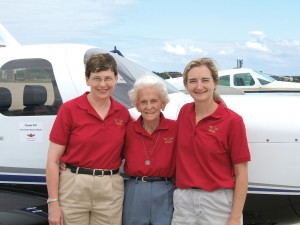
L to R: Gretchen Jahn, 86-year-old Ruby Sheldon and Julie Filucci in front of Jahn’s new 2005 Mooney Ovation2, before racing in the 2005 Air Race Classic.
Jahn knows from personal experience just how fast the Acclaim can go. She flew the M20TN Acclaim to Sun ‘n Fun in April.
“At 25,000 feet, I was showing 236 knots true airspeed; it was burning 20.6 gallons per hour, which isn’t much for that speed in this turbo,” she jubilantly pointed out. “The Acclaim is the fastest Mooney we’ve ever built.”
The Acclaim’s design comes from an upgraded Bravo. Jahn thinks a lot of people will purchase the Acclaim, which lists for $495,000, and gives customers many options. Jahn says the majority of those customers are between ages 45 to 55.
“They’re well into their careers; they’ve made a goodly amount of money, and they’re looking for an airplane like what we have to satisfy their specific transportation needs,” she said. “If you’re looking for the sports car of the air, you’ll find that a Mooney fits that bill, but the Acclaim is the ultimate sports car of the air because of its speed and efficiency.”
She said that although the Acclaim is fast and quite stylish, it’s really for people looking to purchase a “step-up plane.” She points out that because Mooney’s planes are high-performance aircraft, an owner-pilot, for instance, “would need to have gained significant piloting experience in a different plane, before stepping up to a Mooney.”
Jahn said that air conditioning and TKS, which is “flight into known icing” protection equipment, is available. And in July or August, the Garmin autopilot upgrade should be available.
“A transition-training program is included in the price of the Acclaim,” she said. “It includes a ground school with explanation of and work with the G1000.”
Purchasers of Mooney’s Acclaim will attend San Antonio, Texas-based Flight Training, Inc., where they’ll get a chance to work with the Garmin, to test out flight plans and figure out how all the knobs and dials work.
“The training includes time in the airplane with an instructor, too,” she added. “A lot of people are transitioning from traditional instruments to the all-glass cockpit, so we make sure they’re proficient with that.”
The Acclaim, powered by a 280-hp turbo-normalised Teledyne Continental TSIO-550G, has twin turbochargers and dual intercoolers maintaining power to altitude.
“For our existing Mooney owners, they can now order a new interior for the J and K model airplanes, which is the same quality interior that we deliver in airplanes today,” she said. “We offer fiberglass panels with Ultraleather, new plush carpet, a new glare- shield console, and if you want, you can upgrade your seats to be covered in leather. It’s just gorgeous!”
Mooney’s Ovation3 isn’t as fast as the Acclaim, but with its TCM IO-550-N engine, it powers through the sky at 197 knots. With the Garmin G1000 integrated avionics suite, inclusive of the GDL69A, it has a weather uplink, infotainment and up-to-the-minute technology.
The Ovation3 series has six-way adjustable leather seats, comfortable lumbar support and Precise Flight speed brakes. As options, you can also have TKS known ice system, a 115.7 cubic-feet oxygen system and a 25,000 BTU air-conditioning system.
The 99s
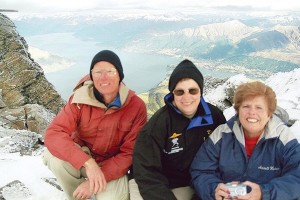
Gretchen Jahn, (center) husband Karl Sutterfield and Mardell Haskins, team 21 during the international Around New Zealand 2004 Air Race, enjoy views atop the clouds from The Remarkables above Queenstown, South Island in New Zealand.
Preserving the unique history of women in aviation is the goal of The Ninety-Nines, Inc., a nonprofit international organization of licensed women pilots from 35 countries, with more than 5,500 members throughout the world. Headquartered in Oklahoma City, Okla., the 99s came into being Nov. 2, 1929, at Curtiss Field, Valley Stream, Long Island, N.Y., when 117 American female pilots had been invited to assemble for mutual support and the advancement of aviation. Louise Thaden, elected secretary, worked tirelessly keeping the group together as it struggled to organize and grow until 1931, when Amelia Earhart was elected as the first president. The group was named for the 99 charter members.
All of the 99s know one thing: although there are other female pilot organizations in various states and nations, virtually all women of achievement in aviation have been or are members of The Ninety-Nines. Jahn would join this elite group, unwittingly, through her husband’s encouragement to learn how to fly in 1985.
“My husband, Karl Sutterfield, tried to teach me how to fly,” she smiled. “I learned how to navigate and read the charts, and I could tune the radios. I could do everything except actually take off and land! Karl was flying before me, and he kept encouraging me to get my license, and my response had always been, ‘Yeah, yeah, yeah.’ But then he was gone on a three-week trip. By the time he came back, I had chosen an instructor; several lessons later I was hooked!”
After she obtained her license, Sutterfield introduced her to the idea of joining a 99s’ chapter in Colorado.
“At that time, the 99s in Colorado sponsored a local one-day handicap speed race. They were looking for people to volunteer, so I raised my hand and said, ‘Sure, but I know nothing about this,'” Jahn laughed.
Her first experience with the 99s wasn’t racing. She was put in charge of timing races at the finish line, at the tower in Santa Fe, N.M.
“I just had a ball; I watched these airplanes zooming down the runway, down the finish line, and I said, ‘I need to do that!’ I was really hooked then,” she said.
A handicap speed race is a way of having slow and fast airplanes compete against each other in the same race, she explained.
“Each airplane is assigned a handicap based on the make and model of the airplane, and then your times are compared to your handicap,” she said. “Whoever does the best against the handicap wins. Now I compete in the 99s’ Air Race Classic, which is an all-women’s four-day (transcontinental) race.”
She describes the Air Race Classic as “the spiritual successor to the Powder Puff Derby.” Also called the Women’s Air Derby, the event took root on Sunday, Aug. 19, 1929, when 20 brave female pilots planned and executed the world’s first women’s cross-country airplane race. The racers took off from Santa Monica, Calif. Seven days later, the race ended in Cleveland, Ohio.
This year, for the Air Race Classic, Jahn and the other female pilots started in Mesa, Ariz., on June 20. After several race stops in many parts of Texas and the Midwest, the race concluded June 23 in Menominee, Mich.
Jahn and her racing partner, Carol Foy, took first place in this year’s race.
The Around New Zealand 2004 Air Race
There aren’t a lot of people around that can say they’ve sat way above the clouds, wrapped by sun and ice at the same time, with a valley floor of flowing, sparkling water beneath them. But that’s exactly what Jahn, her husband, and her good friend Mardell Haskins got to do, as they took in the view from The Remarkables, above Queenstown, South Island in New Zealand. This would be one of many splendid events that the threesome would experience during the international Around New Zealand 2004 Air Race.
The race wasn’t so much a race as it was a flying tour, Jahn explained. Each day was full of unseen beauty, adventure and risk, and a means to admire New Zealand and other countries as well.
“This was the trip of a lifetime,” she said. “It started with me and my husband in Dunedin, New Zealand, which is on the South Island, after we got our New Zealand PPLs (private pilot licenses) together. We both learned new things above and beyond what you’d need to know for flying an airplane in the U.S.”
Jahn said that in New Zealand, learning low-level flying techniques was essential.
“That’s in case you need to put the airplane down in the middle of a sheep field,” she laughed. “I learned that if you can see the head of a cow, you’re at a thousand feet; if you can see the head of a sheep, you’re at 500 feet! You learn about flying in volcanic zones, mandatory broadcast zones and this nifty little thing called a ‘coastal reversal turn.’ The furthest away you can get over the ocean is about 50 miles, so if you’re flying along the coast and run into some weather, a costal reversal turn is a way of reversing your course that maximizes your chances of finding land.”
Jahn said they learned other flying techniques, all while flying in her Cessna 182 before the Around New Zealand Air Race started, which was in Auckland, on the North Island.
“The racecourse zigzagged all over the country,” she explained. “It’s one way of taking a country that’s 950 miles from tip to tip and making about 3,500 miles out of it. This whole thing took two weeks. You’d fly a leg in the morning, which would be about 2.5 hours, then you’d stop for lunch, and after having a briefing, we’d fly in the afternoon and stop—have a beer, some dinner—then stay overnight to start over in the morning.”
The race included four teams from the U.S., five from Australia, three from England, one from Switzerland and one from Hong Kong, with a lone Frenchman and German who were both teamed with New Zealanders. All together there were 155 pilots; 12 members of the race committee in six chase planes accompanied the racers, which included a helicopter piloted by a female team.
“The planes in the race varied from a Beech King Air that could fly 400 miles per hour to an 80-mile-per-hour Piper Pacer, plus various models in between,” Jahn said.
The daily hectic race schedule consisted of two race days, with a one-day rest period, during which Jahn and her husband opted to do a lot of sightseeing.
“We sampled all sorts of New Zealand beers and wines, plus we got to see a lot of the countryside, as there were many checkpoints,” she said. “Your navigation served as the compass and charts. It had a GPS that was covered up for backup purposes in case you really got lost, and then there were penalty points for using it. The VORs didn’t work on this airplane, but there weren’t any around anyway, so it didn’t matter.”
She said the trip was dependent on piloting skill and patience.
“We saw a lot of lighthouses, which were our checkpoints,” she said. “You’d turn around a lighthouse, and you’d have to answer questions: ‘What’s the color of this door? What’s the shape of the top of this lighthouse?’ That’s how they knew that you were really there.”
During the race, an interesting but peculiar airport in Blenheim stood out in Jahn’s mind.
“It had a railroad that went through the middle of the runway!” she said. “They used light signals to alert you to whether there was a train running, so you either used a different runway or you landed long.”
There were two different races at once. As team 21, Jahn and Sutterfield entered a speed race against a handicap. For the second, a proficiency race, a team gave the judges their estimates for hitting all the checkpoints and getting to the finish line for that leg. Whoever did the best against those estimates received the top prizes. But the wildness of the race was that all the planes flew at the same time, on the same leg, to the same place, regardless of which race someone entered or of the speed of each plane.
“There were 62 airplanes registered in the race, with 60 starting and 57 finishing, including us, but we didn’t finish in the top,” Jahn said. “We had two goals; the first was not to get lost, and the second was not to become famous. You became famous by having an accident or something like that, so we weren’t famous!”
However, Jahn’s friend, Haskins, who is also a member of the 99s, wasn’t so lucky. After Haskins and Danielle Boven, who made up team 15, made the first emergency landing of the race, the day before registrations, Jahn and Sutterfield came to their rescue along with another team. Haskins ended up with Jahn and her husband for the race, thus they enjoyed the view from The Remarkables together.
“There were other teams who also assisted pilots; this race was also about the true sprit of race pilots from around the world,” Jahn said. “Several of the local teams split up to fly with less experienced pilots, too, as we all faced challenges. We had to fly in rugged, glacier mountain canyons that had narrow passages.”
In an article published in the Ninety-Nines News, recalling the race, Haskins said although they took in some awesome views, they also experienced some scary moments. One scary moment, she recalled, was when they flew up narrow glacier canyons and Arthur’s Pass was snowed in; planes were flying in both directions up the valley on the south side and then back down on the north side when they had to turn around and come back.
Jahn recalled that part of the Around New Zealand 2004 Air Race, and said it was the hardest race she’s ever flown.
A balance of nature and soul
In Jahn’s lifetime, she’s owned numerous aircraft.
“I learned how to fly in a Cessna 150, just like everybody else,” she laughed.
She’s also piloted Cessna’s 152, 172, 182, 182RG and 205, plus quite a few Mooney planes.
“I’ve flown a Mooney M20J-201, M20-E, Ovation, Eagle, Bravo, and of course, I love the Acclaim; it’s so fast!” she said. “I’ve flown the Maule M5-180, Alpha 120 and 160, Piper Dakota, Beech F-33A and Duchess, and even a Cirrus SR-20. And I’ve flown right seat in a bunch of other planes, with the most unusual being a DC-3, Mooney Mustang and an L-39. I really am hooked on aviation.”
Jahn is equally hooked on Mooney, and has big plans to take the company to new horizons. She said she’d continue to race airplanes; that’s become a real passion for her. And whenever she gets the chance, she and her husband will fly off to some desolate place—enjoying nature, to keep a balance in her mind and soul.
For more information, call 800-456-3033 or visit [http://www.mooney.com].











